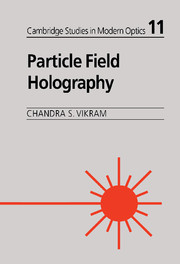Book contents
- Frontmatter
- Contents
- Foreword
- Preface
- Acknowledgements
- 1 Historical background
- 2 Introduction to holography
- 3 General theory of in-line Fraunhofer holography
- 4 System design considerations
- 5 Practical considerations
- 6 Analysis of reconstruction
- 7 Aberrations and their control
- 8 Hologram fringe-contrast and its enhancement
- 9 Non-image plane analysis
- 10 Velocimetry and high speed holography
- 11 The off-axis approach
- References
- Index
Foreword
Published online by Cambridge University Press: 13 October 2009
- Frontmatter
- Contents
- Foreword
- Preface
- Acknowledgements
- 1 Historical background
- 2 Introduction to holography
- 3 General theory of in-line Fraunhofer holography
- 4 System design considerations
- 5 Practical considerations
- 6 Analysis of reconstruction
- 7 Aberrations and their control
- 8 Hologram fringe-contrast and its enhancement
- 9 Non-image plane analysis
- 10 Velocimetry and high speed holography
- 11 The off-axis approach
- References
- Index
Summary
It was with some considerable pleasure that I accepted Chandra Vikram's invitation to prepare a foreword for his book on particle field holography. He has made major contributions to this field – both to its science and its technology. This book is a fine summary of the current state-of-the-art and goes hand-in-hand with the recently published SPIE Milestone Series volume on Selected Papers on Holographic Particle Diagnostics (MS21).
Certainly it is always flattering to be asked to write a foreword to a volume such as this. In this particular case, however, I happen to have a special relationship to the subject matter of particle field holography. I had the good fortune to be one of the co-founders of this particular area of endeavor and have continued to be involved in it from time to time with some modest contributions of my own, but more importantly with some significant work jointly with professional colleagues and with first-rate graduate students as part of their individual Ph.D. theses.
It is hard to believe that this particular application of holography started nearly 30 years ago and in a rather interesting way. As I chronicled in a recent review paper.
The first suggestions about using lasers in particle and droplet size measurement come from Bernard Silverman and his co-workers at the Air Force Cambridge Research Laboratories in Bedford, Massachusetts in 1962–63. They attempted to use laser shadowgraphs to measure the particle size of a sample of objects. […]
- Type
- Chapter
- Information
- Particle Field Holography , pp. xiii - xviPublisher: Cambridge University PressPrint publication year: 1992

